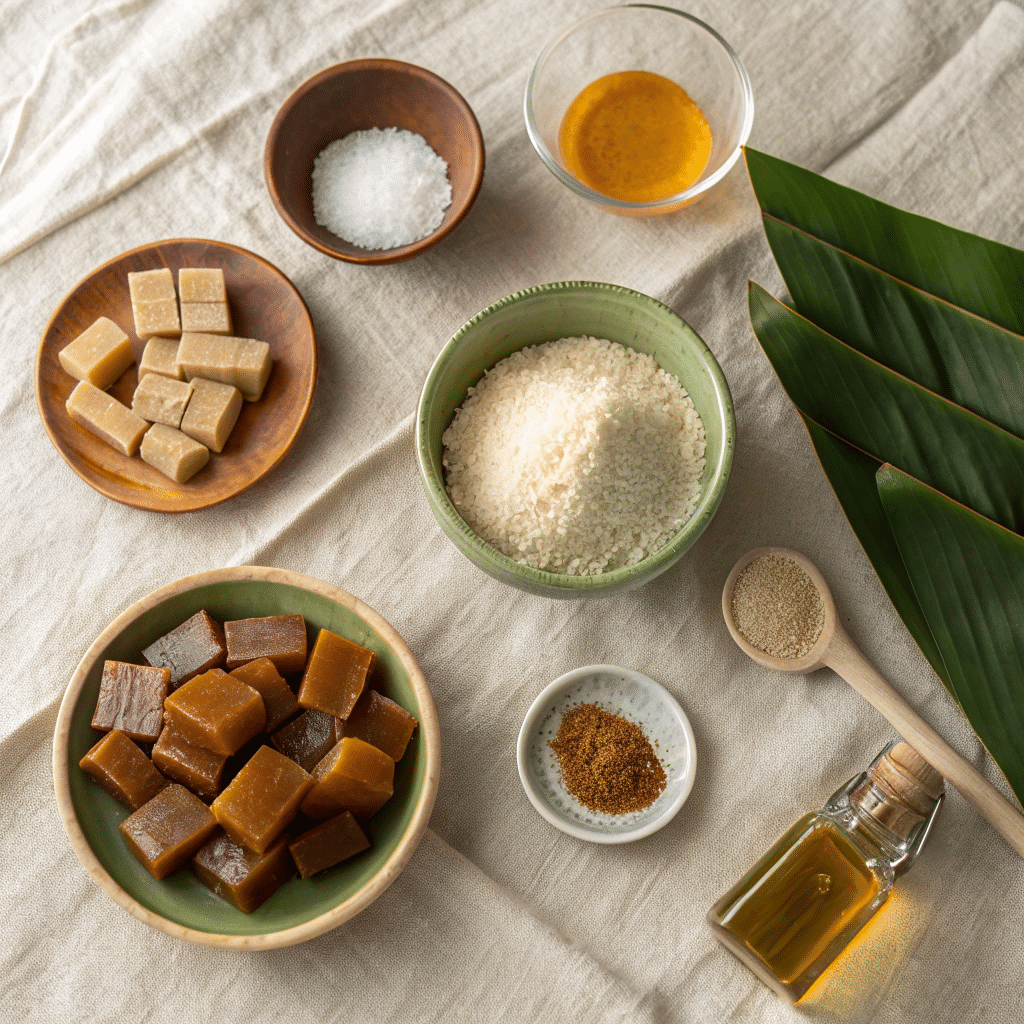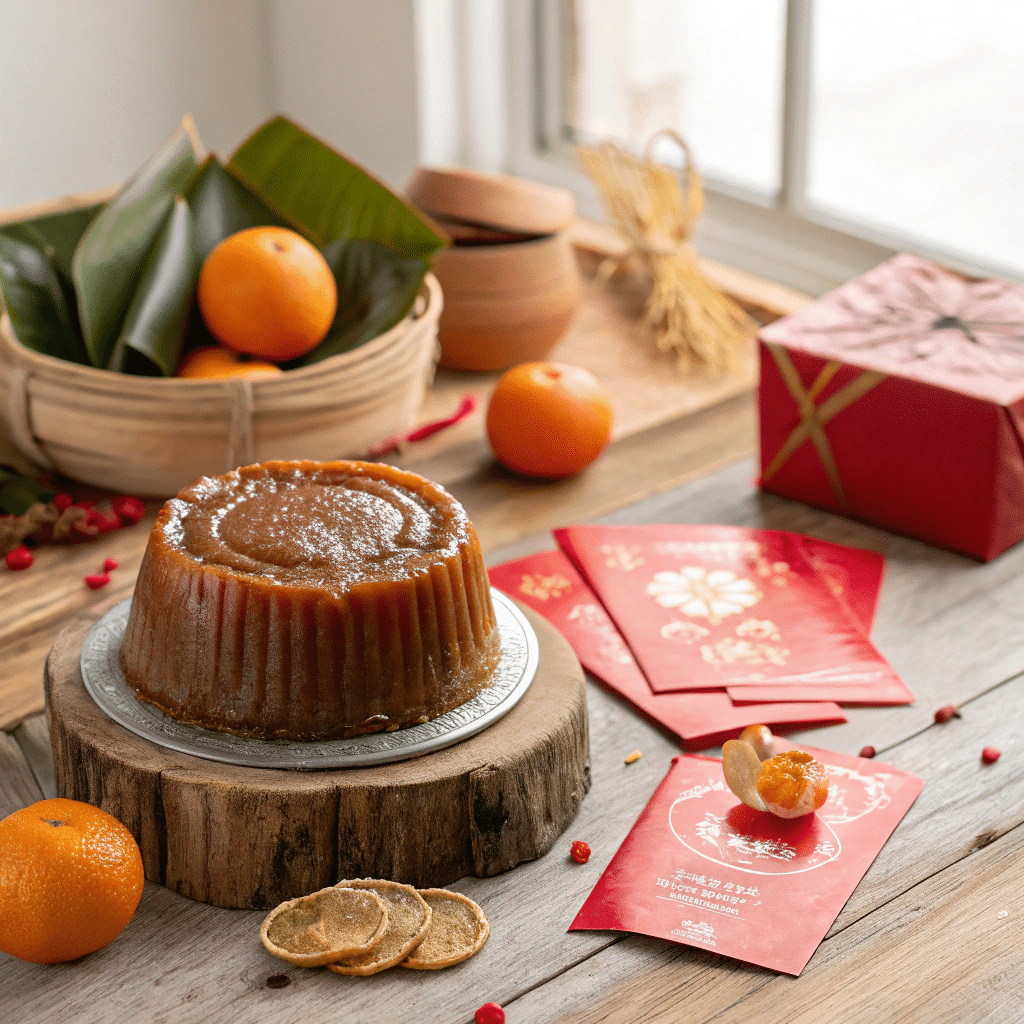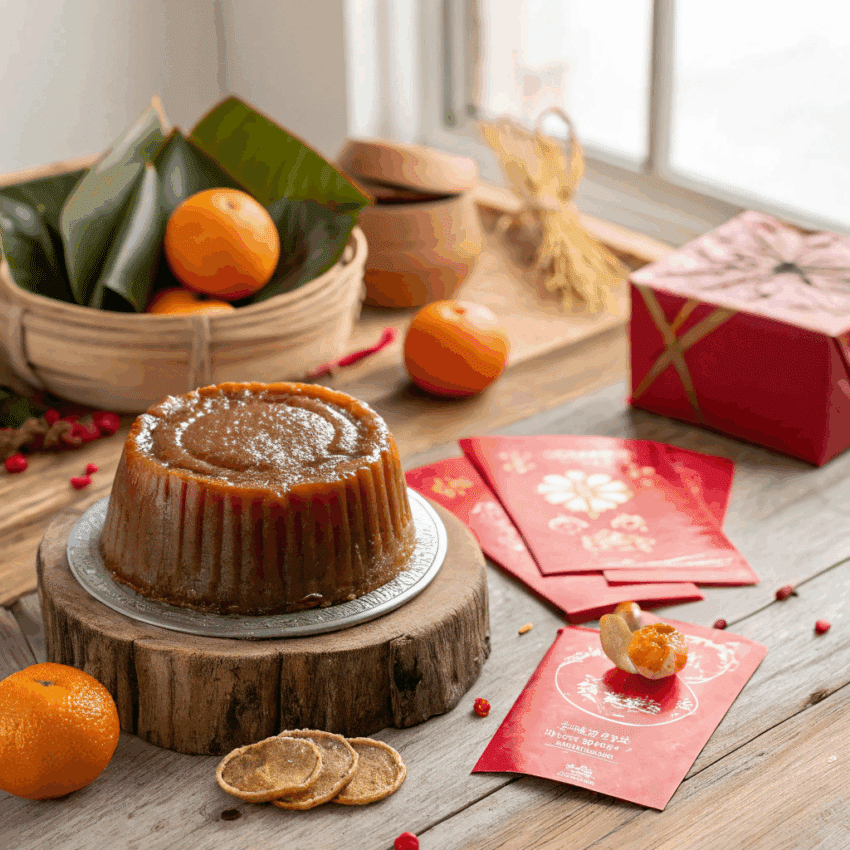If there’s one dessert that always finds its way to my table every Chinese New Year, it’s Kue Keranjang. Sweet, sticky, and packed with meaning, this traditional Chinese New Year cake—also called Nian Gao—is more than just dessert. It’s a symbol of prosperity, family, and fresh beginnings.
I still remember the first time I made it at home. The air smelled faintly of caramel, and the whole kitchen felt like it was coated in sweetness. That golden-brown sticky rice cake, soft yet firm, sat proudly on the counter like a badge of honor. It wasn’t fancy, but it represented something special—patience, togetherness, and celebration.
What Is Kue Keranjang?
Kue Keranjang, often known as Nian Gao in Mandarin, translates to “year cake.” It’s traditionally enjoyed during the Lunar New Year, especially among Chinese and Peranakan families. Made from glutinous rice flour and brown sugar, it’s steamed until glossy and chewy—almost like a sweet rice caramel.
In Chinese culture, the stickiness symbolizes family unity, while the name Nian Gao sounds like “higher year,” symbolizing growth and success. Every slice feels like a wish for good fortune in the year ahead.
Across Southeast Asia—especially Indonesia—you’ll find local twists. Indonesian Kue Keranjang often uses palm sugar for a deeper molasses flavor, wrapped in banana leaves or wax paper molds. The result? A dessert that bridges Chinese roots with Indonesian warmth.
Why You’ll Love This Chinese New Year Cake
- It’s simple, comforting, and full of cultural meaning.
- You only need a few basic ingredients—no fancy tools required.
- It keeps for weeks and tastes even better with time.
- You can eat it plain, fried, or paired with coconut and sesame.
Whether you’re Chinese, Indonesian, or just a dessert lover at heart, this cake has a way of bringing people together.
Ingredients You’ll Need

Here’s what you’ll need to make this traditional sticky rice cake:
- 400g glutinous rice flour – this gives the cake its chewy texture.
- 300g brown sugar or palm sugar – for that rich caramel flavor.
- 250ml water – helps melt the sugar.
- 1 tablespoon vegetable oil – keeps the texture soft.
- Banana leaves or parchment paper – for lining your molds.
Optional flavorings:
- A pinch of salt to balance the sweetness.
- A few slices of fresh ginger for aroma.
- Sesame seeds or shredded coconut for topping.
Step-by-Step Recipe
Step 1: Prepare the Molds
Grease small round pans or ramekins with a bit of oil. Line them with banana leaves (or parchment) so the cake won’t stick.
Step 2: Make the Sugar Syrup
In a saucepan, combine the sugar and water. Heat gently until the sugar dissolves and turns a dark golden brown. If you’re using palm sugar, strain out any impurities. Let it cool slightly before mixing.
Step 3: Mix the Batter
In a large bowl, pour the syrup into the glutinous rice flour. Stir slowly until smooth and lump-free. Add oil and stir again. The batter should look glossy and thick, like honey.
Step 4: Steam the Cake
Pour the batter into your prepared molds. Steam over medium heat for about 1.5 to 2 hours, depending on size. If water drips on the surface, cover the molds with foil or cloth.
Step 5: Cool and Rest
Once steamed, let the cakes cool completely. This part is important! The texture firms up as it rests. Traditionally, Kue Keranjang is allowed to “age” for a few days before eating—it becomes firmer and easier to slice.
How to Serve Kue Keranjang
You can serve this cake as-is, sliced and enjoyed with tea. But if you want to take it up a notch, try one of these popular versions:
- Fried Kue Keranjang – Dip slices in beaten egg, fry until golden and crisp outside, gooey inside.
- Sandwiched Style – Place a slice of taro or sweet potato between two thin slices of Kue Keranjang, then fry it. Sweet, salty, and addictive.
- Coconut Topping – Steam the cake again and top with grated coconut for a fragrant, Peranakan-style twist.
It’s one of those desserts that somehow tastes like nostalgia—no matter where you come from.
Storage Tips
- Room Temperature: Wrapped tightly, it keeps for up to a week.
- Fridge: Store up to 1 month; re-steam before serving.
- Freezer: Freeze slices individually, then thaw and fry whenever a craving hits.
Kue Keranjang actually improves in flavor after a few days. It firms up slightly, letting you slice it perfectly thin without sticking to everything in sight.
Cultural Significance
In many homes, this sticky rice cake sits proudly on the altar during Chinese New Year celebrations. It’s offered to ancestors and the Kitchen God—legend says the sticky texture “sweetens” his words when he reports on the family’s behavior to the heavens.
Whether or not you believe the story, the symbolism is beautiful. Sweetness, unity, and progress—it’s everything we hope for in the year ahead.
Even in Indonesia, where it’s often shared among neighbors and friends, Kue Keranjang stands as a delicious reminder of heritage and connection. A little slice of culture, shared with love.
Tips for the Perfect Kue Keranjang
- Don’t rush the steaming—it’s what gives the cake that perfect sticky chew.
- Use good-quality brown sugar or palm sugar; it makes all the difference.
- Let it rest before cutting. The patience pays off.
- If your cake cracks, don’t panic—it’s still delicious!
Other Chinese New Year Treats to Try
If you’re building a New Year dessert table, add a few more favorites:
- Chinese Almond Cookies – crumbly, nutty, and perfect with tea.
- Sesame Balls (Jian Dui) – crisp outside, chewy inside, filled with red bean.
- Steamed Sponge Cake (Ma Lai Gao) – light, fluffy, and fragrant.
Each one tells its own story, but Kue Keranjang remains the heart of the celebration.

Kue Keranjang (Chinese New Year Cake / Nian Gao)
Ingredients
Method
- Lightly grease small round pans or ramekins with oil. Line them with banana leaves or parchment paper to keep the cake from sticking.
- In a saucepan, mix brown sugar (or palm sugar) with water. Heat gently until it fully dissolves and turns into a smooth, dark golden syrup. If using palm sugar, strain to remove any grit. Let it cool slightly.
- In a large mixing bowl, pour the warm syrup into the glutinous rice flour. Stir slowly until smooth and thick, like honey. Add the oil and mix again until glossy.
- Pour the batter into your prepared molds. Steam on medium heat for 1½ to 2 hours, depending on size. If water drips onto the surface, cover the molds with foil or a clean cloth.
- Remove the cakes from the steamer and let them cool completely. For the best texture, let the cake rest for 2–3 days before slicing. This helps it firm up and become easy to cut.
- You can enjoy it as-is or pan-fry it. To fry, dip slices in beaten egg and cook on medium heat until golden and crisp on the outside but soft and chewy inside.
Notes
- Let the cake “age” for at least two days before slicing — it’ll be less sticky and easier to handle.
- Store it wrapped at room temperature for a week or in the fridge for a month.
- When frying, don’t rush. Slow heat gives the best crisp edges and chewy centers.
- You can also wrap small slices in banana leaves, re-steam them, and serve with coconut for a fragrant twist.
FAQs
1. What does Kue Keranjang taste like?
It’s sweet, chewy, and caramel-like with deep notes from the brown or palm sugar. Some describe it as a mix between caramel pudding and mochi.
2. Can I bake Kue Keranjang instead of steaming it?
Traditionally, it’s steamed for the best texture. Baking changes the consistency and flavor, so stick with steaming.
3. Why is it called “Nian Gao”?
“Nian Gao” sounds like “higher year” in Mandarin, symbolizing progress and prosperity.
4. How long can it be stored?
Properly wrapped, it can last for weeks. Just reheat before serving for the best texture.
5. Can I use coconut sugar?
Yes! Coconut sugar adds a lovely smoky flavor that pairs beautifully with glutinous rice.
6. Is it gluten-free?
Yes, since it’s made with glutinous rice flour (which contains no gluten), it’s naturally gluten-free.
Final Thoughts
Every bite of Kue Keranjang carries a story—one of hope, sweetness, and celebration. Whether you grew up eating it during Chinese New Year or you’re discovering it for the first time, it’s a dessert that reminds you to slow down, share joy, and savor the moment.
So this year, when the fireworks fade and the table fills with laughter, let that little round cake remind you: life’s stickiest moments are often the sweetest.

